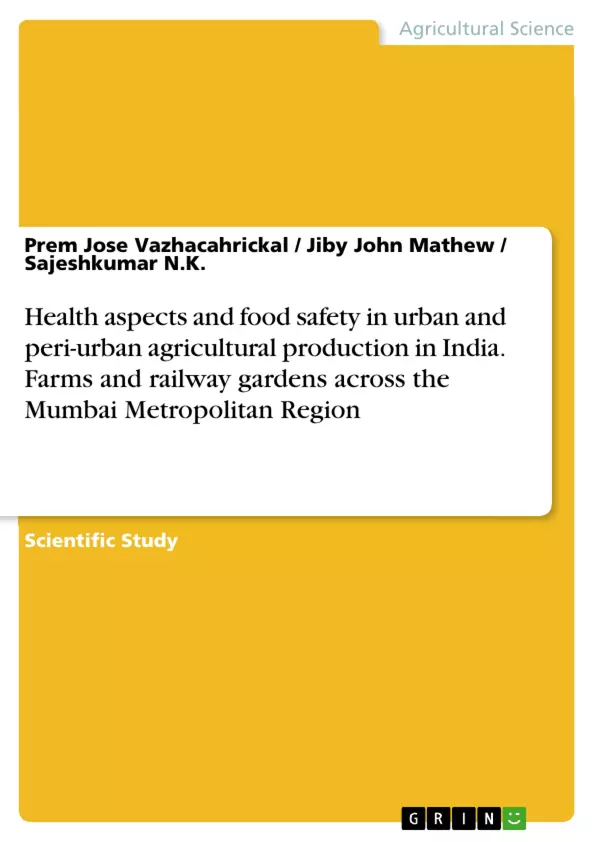Urban and peri-urban agriculture (UPA) provide a significant role in ensuring urban food security, income generation and livelihood strategies and supports Millennium Development Goals (MDGs). Quantitative data about the phytoavailability and food chain transfer of heavy metals in Mumbai Metropolitan Region (MMR) is scarce.
This study was conducted to characterize the elemental and heavy metal transfer among major UPA production systems (farms and railway gardens), in MMR eliciting the soil to root translocation as well as its localization in produce. It comprises a detailed two year onsite examination of three farms (F1-3) and three railway gardens (RG1-3) across MMR. Potential risk assessments were conducted by metal transfer factor (MTF), metal translocation (TF), daily intake of metals (DIM), health risk index (HRI), average daily dose (ADD) and target hazard quotient (THQ) as well as total metal and element content in comparison with different safety standards.
Copper concentration in soils ranged from 29.7 - 545.1 mg kg-1, with highest and lowest concentrations observed at RG3 and RG2 respectively. The shoots of white radish accumulated Sr concentrations up to 424.1 mg kg-1 at RG2. Strontium had a TF up to 32.25 in comparison with Co, Cu, Zn, Ni and Cr with a maximum of 5.93, 5.32, 3.41, 1.71 and 1.47 respectively. Average daily dose of Zn was between 1.3 × 10-1 and 3.6 × 10-1 mg kg-1 d-1 while Ni had a daily dose of between 4.6 × 10-2 and 7.4 × 10-2 mg kg-1 d-1. The estimated values of ADD were below the world standard levels except for Zn and Ni, there is a relative absence of health risk imposed by the ingestion of these vegetables produced in UPA systems in MMR.
Inhaltsverzeichnis (Table of Contents)
- 1. Introduction
- 2. Materials and Methods
- 2.1 Study area
- 2.2 Site description, produce sampling and analysis
- 2.3 Data analyses
- 2.4 Statistical analysis
- 3. Results
- 3.1 Soil element and heavy metal concentration
- 3.2 Produce element and heavy metal concentration
- 3.3 Heavy metal transfer and translocation
- 3.4 Heavy metal exposure and hazard index
- 4. Discussion
- 5. Conclusions
Zielsetzung und Themenschwerpunkte (Objectives and Key Themes)
This research investigates the health aspects and food safety concerns associated with urban and peri-urban agricultural production in the Mumbai Metropolitan Region, India. The study compares the levels of heavy metals in soil and produce from railway gardens and conventional farms, highlighting the potential risks associated with these agricultural practices.
- Heavy metal contamination in urban and peri-urban agriculture
- Food safety and health risks associated with heavy metal exposure
- Comparison of heavy metal levels in soil and produce from railway gardens and farms
- Potential impact of heavy metal contamination on human health
- Sustainable agricultural practices and food safety in urban environments
Zusammenfassung der Kapitel (Chapter Summaries)
- Chapter 1: Introduction This chapter provides an overview of urban and peri-urban agriculture, focusing on the importance of food security and the potential risks associated with heavy metal contamination. It also outlines the research objectives and the specific study area in Mumbai, India.
- Chapter 2: Materials and Methods This chapter details the methodology used in the study, including the selection of study sites (railway gardens and farms), the sampling procedures for soil and produce, and the analytical methods employed to determine heavy metal concentrations.
- Chapter 3: Results This chapter presents the findings of the study, including the levels of heavy metals in soil and produce from both railway gardens and farms. It also analyzes the transfer and translocation of heavy metals from soil to plants and explores the potential health risks associated with heavy metal exposure.
- Chapter 4: Discussion This chapter discusses the implications of the research findings, considering the factors contributing to heavy metal contamination in urban and peri-urban agricultural systems. It also explores the potential health risks associated with consuming produce from these areas and suggests strategies for mitigating heavy metal contamination.
Schlüsselwörter (Keywords)
Urban agriculture, peri-urban agriculture, heavy metals, food safety, soil contamination, produce contamination, human health, Mumbai, India, railway gardens, farms, sustainable agriculture.
- Arbeit zitieren
- Dr. Prem Jose Vazhacahrickal (Autor:in), Jiby John Mathew (Autor:in), Sajeshkumar N.K. (Autor:in), 2016, Health aspects and food safety in urban and peri-urban agricultural production in India. Farms and railway gardens across the Mumbai Metropolitan Region, München, GRIN Verlag, https://www.grin.com/document/343270



